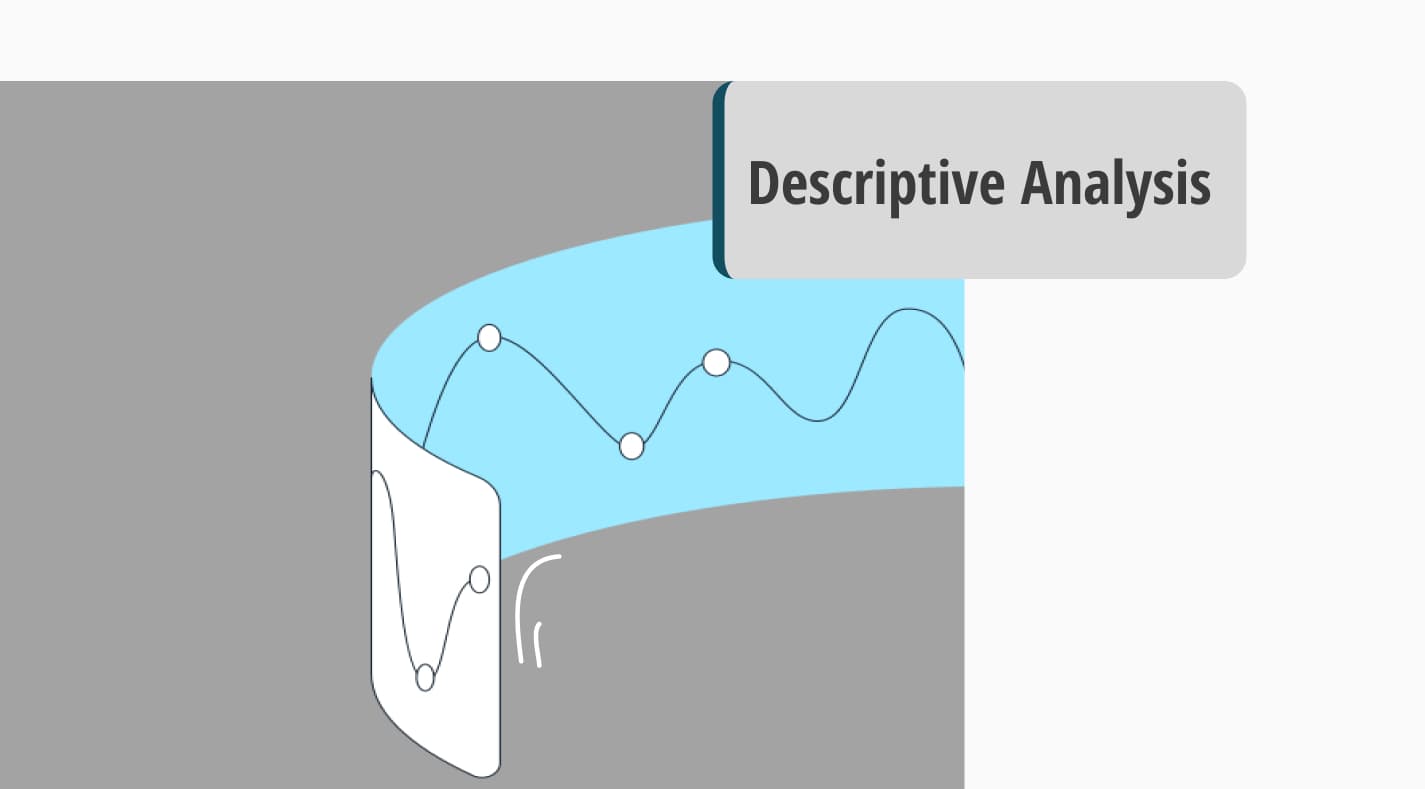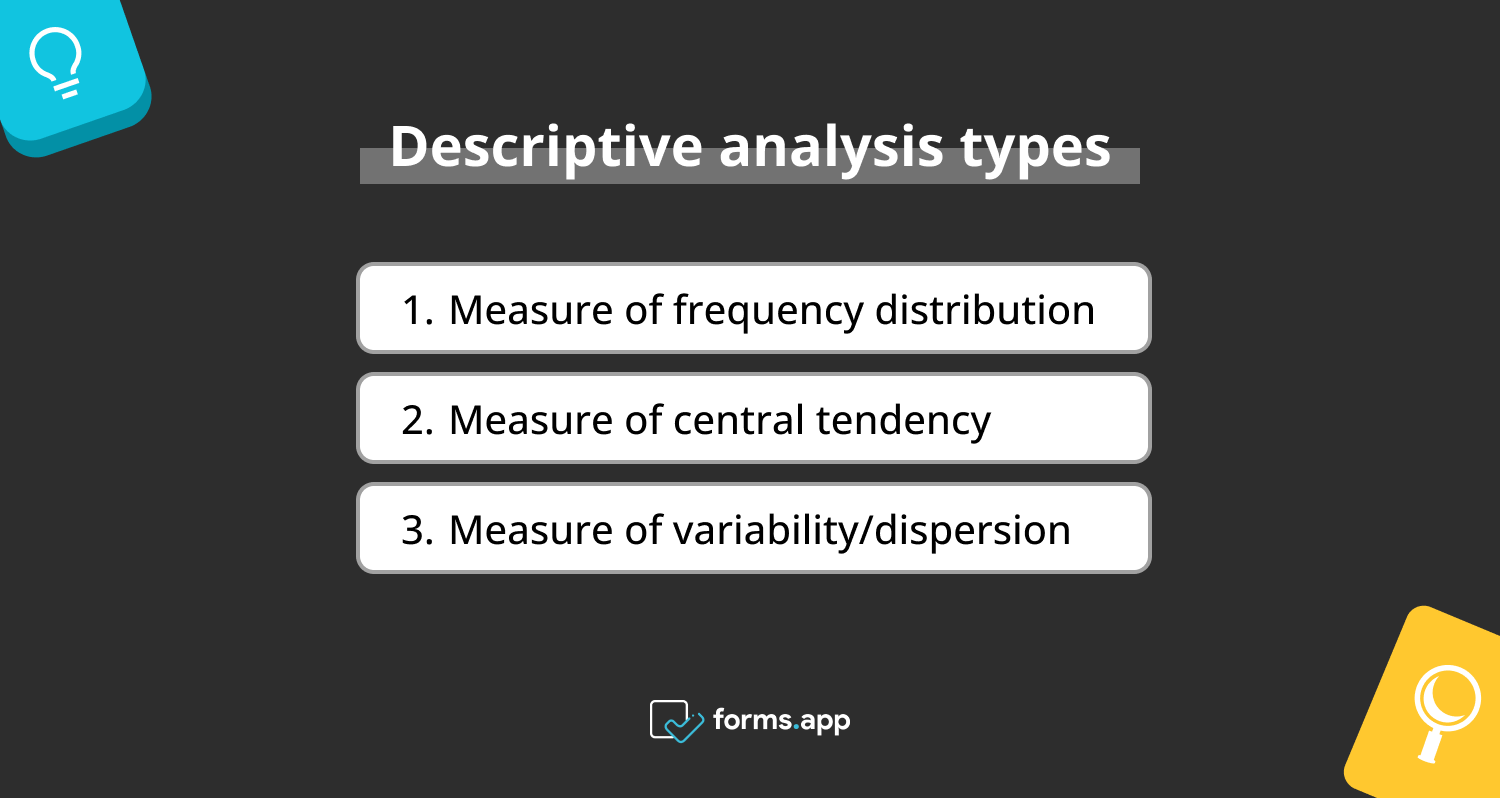
Has your business's profit rate decreased? Did your newly opened shop bring in more income this season? Have your customers expressed their dissatisfaction lately? You can collect historical data and apply descriptive analysis to find out the reasons. It will help you to identify key factors about the event. It will show your good or weak sides.
In this article, you will see how you can benefit from descriptive analysis. It is not a complicated research method. So you shouldn't need to worry about it. But first, you need to know its definition, so start from the heading below.
What is descriptive analysis?
Descriptive analysis is a data analysis technique using historical data to describe and demonstrate a condition.
It reveals the patterns and relationships of data points in the simplest way. That's why it gives the quickest response to find out why an event happened. On the other hand, because of this simplicity, researchers sometimes need to make manual inputs. However, they can achieve productive results when they work systematically.
Descriptive statistical analysis is often called the most basic analysis for summarizing data. That's why it's frequently used as a stepping stone to other types of comprehensive analysis, such as diagnostic analysis, predictive analysis, and prescriptive analysis.
Descriptive analysis types
There are three types of descriptive analysis tools that you can utilize. Although these are generally associated with univariate analysis methods, you can also use them with statistics methods such as bivariate, multivariate, and time series.
Since a lot of calculations are required, it is used with many calculation programs.
For example, descriptive analysis in Excel allows users to calculate summary statistics of their dataset. Below, you can check each of the types with descriptive analysis examples to get a better understanding of the topic:

Types of descriptive analysis
1. Measure of frequency distribution
It can be the most basic summary of the dataset. It is used to show how often each value occurs in a dataset. However, you should remember that it is slightly different than the mode. It will be explained with an example.
Example: There are four different phone brands in the market. These are A, B, C and D brands. The daily sales amount of brand A phones is 3, B phones is 4, C phones is 5 and D phones is 6. These are, respectively, the frequency distribution. On the other hand, there is no mode in this dataset because there is no frequent number. With this simple process, you can identify patterns and then make informed decisions.
2. Measure of central tendency
It is used to find the average of a dataset. It also serves as a body for using other measures. There are three common measures you can use: mean, median, and mode.
- The mean is the mathematical average of values. You add all numbers together and divide them by the total number of values. You can apply the sample mean formula if you want to examine a specific group in your analysis.
- The median is the middle point in the dataset. You can use formulas based on odd and even numbers to find the median of a dataset.
- Lastly, the mode is the most frequent value. There is no rule that there will always be a mode. Sometimes, there are no modes, or there is more than one mode.
Example: Assume that you collected data about your customers’ ages. The average of their ages will show you the mean. For example, it is 32. Now, you analyze the mode and find its value to be 30. Now, you can use this data. You may take action to increase the satisfaction of your customers in their 30s by focusing on them, or you can consider this analysis as a start if you want to reach wider age ranges.
3. Measure of variability/dispersion
It finds the dispersion of data points by describing how far they are from the distribution point and each other. There are four common measures you can use: range, interquartile range, standard deviation, and variance.
- The range is the difference between the highest and the lowest values.
- The interquartile range is the middle half of a distribution.
- The standard deviation is the average distance from the mean.
- The variance is the average of squared distances from the mean.
Example: You are considering providing standard deviation to measure and prove your data quality. The data you have contains the product prices that customers prefer most. These are worth $20, $25, $30, $35, and $40, respectively. When you average it, it becomes 30. When you look at how much the other values deviate from the mean value, you find that the variance is 62.5, and the standard deviation is 7.9.
Frequently asked questions about descriptive analysis
Do you have more questions about descriptive analysis? Do you want to make yourself proficient in this type of analysis? You can check out the most common inquiries around it below.
Vous pouvez utiliser l'analyse descriptive dans différents scénarios. Par exemple, vous pouvez analyser le trafic du site web de votre entreprise pour savoir où les gens vous trouvent sur le web. Vous pouvez comprendre les tendances des produits en examinant l'historique des achats dans votre magasin. Vous pouvez ainsi prendre des mesures pour satisfaire les clients en fonction de la demande.
Il s'agit dans les deux cas de techniques appropriées pour effectuer une analyse descriptive. Toutefois, certains scientifiques des données peuvent trouver l'analyse descriptive quantitative plus concrète et plus scientifique. Cependant, le fait que l'analyse qualitative soit adoptée même par les grandes entreprises montre que ce type d'analyse est également essentiel.
Tout d'abord, les mesures de fréquence. Il s'agit d'exprimer la fréquence d'un événement en général par des expressions numériques. Deuxièmement, les mesures de tendance centrale. L'objectif est de trouver la tendance générale en calculant la moyenne, la médiane et le mode. Troisièmement, les mesures de dispersion. Elles visent à mesurer la distribution des données en utilisant l'étendue ou l'écart type. Enfin, les mesures de position. Elles visent à mesurer la relation d'une valeur avec d'autres valeurs et son environnement.
L'analyse descriptive est applicable dans tous les domaines où des données sont disponibles. Par exemple, les entreprises peuvent l'utiliser pour obtenir des informations sur leurs clients et améliorer leurs stratégies de développement de produits et de marketing. Elle peut être utilisée dans le domaine de l'éducation pour élaborer des stratégies et des développements concernant les étudiants, les examens et les cours. Dans le domaine de la finance, elle peut être utilisée pour obtenir des informations sur des sujets tels que les actions, l'inflation, les bénéfices des entreprises, etc.
L'analyse descriptive est le type d'analyse de données le plus simple et le plus fondamental. En effet, elle transmet ce qui est tel quel, sans ajouter d'éléments ou d'interprétations. Ainsi, si vous avez besoin d'un diagnostic rapide de ce qui s'est passé, l'analyse descriptive sera toujours là pour vous. L'apport humain est plus important que ce que l'analyse révèle. C'est pourquoi l'analyse descriptive est souvent utilisée pour l'analyse de données non exhaustives.
Key points to take away
Descriptive analysis is the fundamental analysis method for business data analysts. It is essential to use it in order to understand what the data is and to make evaluations accordingly. It is waiting to be used to unearth fundamental phenomena and assist businesses in historical data research.
In this article, descriptive analysis is explained, as well as its various types. Other important points are also mentioned in the FAQ section. After this, you can now use descriptive analysis to understand the data. You're ready to utilize historical data to make insightful decisions.
Atakan is a content writer at forms.app. He likes to research various fields like history, sociology, and psychology. He knows English and Korean. His expertise lies in data analysis, data types, and methods.



 4 minutes de lecture
4 minutes de lecture

